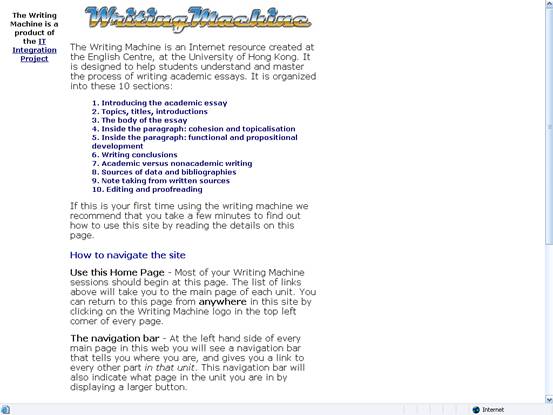- 廖柏森
香港大學不僅在亞洲的高等教育界首屈一指,也是世界級的名校。在泰晤士高等教育(Times Higher Education) 2010年世界大學排名上,香港大學為第21名;在QS (Quacquarelli Symonds) 2010年世界大學的排名則為第23名;而且兩個機構皆把香港大學評為亞洲最佳的大學。該校於1912年建校,自英國殖民期間至今近百年來一貫採英語教學,學生以英文寫作是理所當然之事,校方也提供許多網路學習資源。以下介紹的網站稱為「寫作機器」 (Writing Machine),是該校英語中心(English Centre)所建製,主要是教導大學生如何撰寫學術報告(academic essay)。
該網站看起來簡單樸素,沒有任何影音或互動的功能,但是資料的呈現相當有系統。第一段話開宗明義就指出這個網站的目的是幫助學生瞭解並熟練撰寫學術報告的過程 (help students understand and master the process of writing academic essays)。學術報告(academic essay)與實證性研究論文(empirical research paper)不太一樣,研究論文通常是研究生需要寫的,常以IMRD為格式,也就是Introduction (緒論)、Method (研究方法)、Results (研究結果)和Discussion (討論)的章節架構;但此網站介紹的學術報告主要是大學生在寫,文字篇幅和研究規模相對較小,格式上就只以Introduction (緒論)、Body (本體)和Conclusion (結論)三部份為架構。而學術報告雖然比研究論文容易寫,但卻是寫好研究論文的基礎。尤其台灣絕大多數的大學生並沒有使用英文撰寫學術報告的訓練和經驗,一旦上了研究所就馬上要寫英文研究論文難免覺得左支右絀,就是因為還沒學會走路就被迫要跑步。因此先學習學術報告的寫作方式,對之後撰寫研究論文一定會有助益。

此網站的內容共分成10個單元,分別為: (1) Introducing the academic essay (介紹學術報告);(2) 主題、題目、緒論 (Topics, title, introduction) ;(3) 報告的本體 (The body of essay);(4) 段落: 銜接與訂主題 (Inside the paragraph: cohesion and topicalisation);(5) 段落: 功能與命題發展(Inside the paragraph: functional and propositional development);(6) 撰寫結論 (Writing conclusions);(7) 學術與非學術寫作 (Academic and nonacademic writing);(8) 資料來源與參考書目 (Sources of data and bibliographies);(9) 從書面資料來源做筆記 (Note taking from written sources);(10) 編輯與校對 (Editing and proofreading)。算是相當全面涵蓋了學術報告的重點。
該網站還提供寫作過程的引導,讓學生有所適從。首先點按Your turn (換你來練習)的Task 1 – Write a draft of your essay (任務一: 撰寫報告初稿)http://www4.caes.hku.hk/writingmachine/bin1/yourturn.htm,即可下載Word檔的寫作過程指引(guide to the process of writing an essay)如下:
Task: Use the following guide to write your own essay.
1. Start by checking the essay topics page[1] on the AEAS web, then think about all topics that you are interested in, that you know something about, and that might make a good academic essay. Discuss these with another student, and then chose the topic that you would like to work on. (e.g. ‘Technology)
TOPIC:
2. Brainstorm and write down all the ideas and examples that you can associate with the topic. (You can use this box, or a sheet of paper.)
3. Set these out as a concept map. (If you don’t know what a concept map is, look at the section on freewriting and outlining in the Writing Turbo Charger[2].)
4. Identify a problem or issue associated with the topic. (E.g. ‘The negative consequences of technology.’)
Problem / issue:
5. State your attitude. (E.g. While technology has brought tremendous progress to humanity, it has also had negative consequences.)
Your attitude:
6. Identify three key points or ideas associated with the topic. (E.g. Technology and unemployment, widening the gap between first and third world countries, technology and social alienation) [For more information about making a plan for your essay, you should see the section on outlining in the Writing Turbo Charger]
1)
2)
3)
7. Come up with an eye-catching title:
Title:
8. Now it’s your turn
Task: Use the following guide to produce a first draft of your essay. Be sure to press the F1 key to get help before you begin each part of your essay!
Paragraph one, the introduction:
The last sentence in paragraph one, the thesis statement:
When you have finished, write your title:
使用以上的表格,可以輔助同學思考整個報告寫作的步驟: (1)發想主題(topic)、(2)腦力激盪(brainstorm)並寫下與主題相關的想法和例證(ideas and examples)、(3)將以上想法例證製成概念圖(concept map)、(4)指出與主題相關的問題或議題 (problems/issues)、(5)陳述你的態度立場 (attitude)、(6)指出與主題相關的三個主要觀點或想法(key points or ideas)、(7)提出醒目的題目 (title)、(8)開始寫作。
接下來該Word檔還相當貼心地提供一個典型的五段式報告格式,第一段是緒論,並且請你把主旨句(thesis statement)寫在該段最後一句。而第二、三、四段是在呈現作者對於主題相關的三個想法或態度,並提出解釋和例證。最後第五段則是總結全文觀點,並在完成全文後才寫出文章的題目。同學在撰寫報告時可以依循這些步驟和格式,應該比毫無頭緒地想到哪、寫到哪的作法更有效率,文章也更有組織系統。
很多同學看到這裡可能以為已經大功告成,寫完一篇報告了。但是回到這個網站的下一部份Review (複檢)還提醒我們,仍需要對剛完成的文章初稿再做回顧檢視,看看有無疏漏或該修訂的地方。點選Review (複檢)http://www4.caes.hku.hk/writingmachine/bin1/review.htm就可進到如下的內容:
對於剛寫完的報告初稿,我們需要反覆檢視並反思以下幾個問題:
l Does it contain a thesis statement?
(文章是否包含主旨句?)
l Did you create an outline plan before/while writing? If not, can you easily construct one from the essay?
(在寫作前或寫作時是否製定大綱計畫? 如果沒有,你是否能輕易地從寫完的報告中整理出來?)
l Do the topic sentences for each major section reflect the main points mentioned in your plan?’
(每個主要段落的主題句是否符合大綱計畫中的重點?)
以上是檢視我們在報告中應該要做的事,同個頁面接下來是檢視撰寫報告時不應該做的事,這些內容對於其它學術文體也適用,其中幾個重點整理摘要如下:
l Do not ask questions (不要向讀者提問): 學術報告中不宜以口語的語氣向讀者提出問題,例如Have you ever wondered what _______________ means? (你曾經想過__________的意義嗎?) 或What do you think?(你覺得如何?)等問句都不太恰當,不需要拐彎抹角,直接切入重點即可(Do not be vague; get to the point.)。
l Try to avoid the use of the word "I" (避免使用第一人稱「我」): 撰寫報告就是在表達自己的意見想法,不需要一直使用第一人稱,例如In my opinion... (我的意見是…)或I think... (我認為…) 或I feel...(我覺得…) 等。有時候使用被 動語態反而比較好,例如寫It has been argued...就比I have argued... (我主張…)恰當。
l Do not be vague in your references (提到參考出處時要明確): 不要使用如 sometime ago the radio said...(不久前收音機報導…), it is written that... (有人曾寫道…), a famous man once said...(一位知名人士曾說過…) 等模糊片語,如果你不記得出處來源,就表示這不是個好例子(If you can’t remember the source, it’s not a good example.)。
l Avoid expressions (避免以下表達方式): 例如 everyone knows... (每個人都知道…), it is common knowledge that... (…是普通常識), we all believe... (我們都相信…),如果是大家都知道的事,你就沒有必要再寫了。
l Do not be informal (文體要正式): 不要使用俚語和縮寫字,例如把do not寫成don’t。
l Don't overgeneralise (不要過度類化): 例如 All Chinese families would prefer to have a baby boy (所有的中國家庭都偏愛生下男嬰) 或Chinese students never question their teacher (中國學生從來不會質疑他們的老師)這樣的論述容易被否證。寫成 Most / many Chinese families...(大多數/許多中國家庭…) 或Chinese students seldom....(中國學生很少…)比較安全。



















